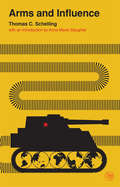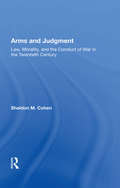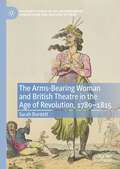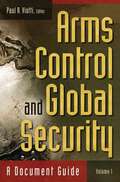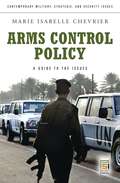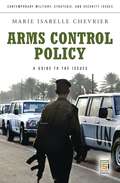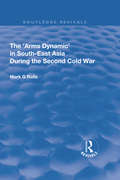- Table View
- List View
The Armourer's House (Red Fox Older Fiction Ser.)
by Rosemary SutcliffIf only she'd been born a boy, Tamsyn would never have been sent away to Uncle Gideon's - the armourer's - house when her grandmother died. She could have stayed by the wild sea that she loved with her Uncle Martin, the ship merchant.But instead, she is bound for busy, bustling Tudor London, and the armourer's house, far from the coast and far from her beloved ships. Homesick and lonely in the loud family of cousins, it isn't until she meets the strange old Wise Woman that Tamsyn is finally promised her "heart's desire"...
Arms and Influence (Veritas Paperbacks)
by Thomas C. Schelling"This is a brilliant and hardheaded book. It will frighten those who prefer not to dwell on the unthinkable and infuriate those who have taken refuge in stereotypes and moral attitudinizing."—Gordon A. Craig, New York Times Book Review Originally published more than fifty years ago, this landmark book explores the ways in which military capabilities—real or imagined—are used, skillfully or clumsily, as bargaining power. Anne-Marie Slaughter’s new introduction to the work shows how Schelling’s framework—conceived of in a time of superpowers and mutually assured destruction—still applies to our multipolar world, where wars are fought as much online as on the ground.
Arms And Judgment: Law, Morality, And The Conduct Of War In The 20th Century
by Sheldon M. CohenThis book examines the justifications of the use of armed force and their limits, as well as the law of war. It is a moral enquiry and adopts an interdisciplinary approach. The divergence between legality and morality, and its significance, is one of the underlying themes of the book.
Arms And Judgment: Law, Morality, And The Conduct Of War In The 20th Century
by Sheldon M. CohenThis book examines the justifications of the use of armed force and their limits, as well as the law of war. It is a moral enquiry and adopts an interdisciplinary approach. The divergence between legality and morality, and its significance, is one of the underlying themes of the book.
Arms and the State: Sir William Armstrong and the Remaking of British Naval Power, 1854–1914 (Modern Economic and Social History)
by Marshall J. BastableArms and the State is a history of Britain's first and foremost modern armaments company, the Armstrong Whitworth Company, from its origins in 1854 to 1914. It focuses on the role of Sir William G. Armstrong, an engineer and entrepreneur who transformed his modest mechanical engineering business into a vast industrial enterprise which invented, developed, manufactured and sold heavy guns and warships throughout the world. Arms and the State reconstructs the global arms trade as it follows Armstrong's companies selling the latest weapons to both sides in the American Civil War, Egypt, Turkey and Italy in the 1860s, to China, Chile and Japan in the 1870s and 1880s, and became Britain's leading armaments company in the age of the naval arms races that preceded the First World War. In so doing, it discusses varied topics such as the social and political nature of technological innovation, the quality of Britain's late-Victorian entrepreneurs, and the impact of armaments on British politics, defence policies, the international arms trade and imperialism. Arms and the State situates the history of the company in its technological, political and international contexts, with particular attention given to the role of British Parliamentary politics and the inner workings of the War Office and Admiralty bureaucracies. The central narrative is Armstrong's role in the militarization of technology in the 1850s, the commercialization of the armaments trade on a global scale in the 1860s and 1870s, and the emergence of the British military-industrial state in the 1880s and 1890s. Arms and the State provides a history of the people, the technology and the business of the Arms trade. It is a fascinating story of the domestic politics, the foreign policy and strategic calculations, the manipulation of the press and the bureaucratic intrigues that lay behind the invention, production and proliferation of the first weapons of mass destruction.
Arms and the State: Sir William Armstrong and the Remaking of British Naval Power, 1854–1914 (Modern Economic and Social History)
by Marshall J. BastableArms and the State is a history of Britain's first and foremost modern armaments company, the Armstrong Whitworth Company, from its origins in 1854 to 1914. It focuses on the role of Sir William G. Armstrong, an engineer and entrepreneur who transformed his modest mechanical engineering business into a vast industrial enterprise which invented, developed, manufactured and sold heavy guns and warships throughout the world. Arms and the State reconstructs the global arms trade as it follows Armstrong's companies selling the latest weapons to both sides in the American Civil War, Egypt, Turkey and Italy in the 1860s, to China, Chile and Japan in the 1870s and 1880s, and became Britain's leading armaments company in the age of the naval arms races that preceded the First World War. In so doing, it discusses varied topics such as the social and political nature of technological innovation, the quality of Britain's late-Victorian entrepreneurs, and the impact of armaments on British politics, defence policies, the international arms trade and imperialism. Arms and the State situates the history of the company in its technological, political and international contexts, with particular attention given to the role of British Parliamentary politics and the inner workings of the War Office and Admiralty bureaucracies. The central narrative is Armstrong's role in the militarization of technology in the 1850s, the commercialization of the armaments trade on a global scale in the 1860s and 1870s, and the emergence of the British military-industrial state in the 1880s and 1890s. Arms and the State provides a history of the people, the technology and the business of the Arms trade. It is a fascinating story of the domestic politics, the foreign policy and strategic calculations, the manipulation of the press and the bureaucratic intrigues that lay behind the invention, production and proliferation of the first weapons of mass destruction.
The Arms-Bearing Woman and British Theatre in the Age of Revolution, 1789-1815 (Palgrave Studies in the Enlightenment, Romanticism and Cultures of Print)
by Sarah BurdettThis book explores shifting representations and receptions of the arms-bearing woman on the British stage during a period in which she comes to stand in Britain as a striking symbol of revolutionary chaos. The book makes a case for viewing the British Romantic theatre as an arena in which the significance of the armed woman is constantly remodelled and reappropriated to fulfil diverse ideological functions. Used to challenge as well as to enforce established notions of sex and gender difference, she is fashioned also as an allegorical tool, serving both to condemn and to champion political and social rebellion at home and abroad. Magnifying heroines who appear on stage wielding pistols, brandishing daggers, thrusting swords, and even firing explosives, the study spotlights the intricate and often surprising ways in which the stage amazon interacts with Anglo-French, Anglo-Irish, Anglo-German, and Anglo-Spanish debates at varying moments across the French revolutionary and Napoleonic campaigns. At the same time, it foregrounds the extent to which new dramatic genres imported from Europe –notably, the German Sturm und Drang and the French-derived melodrama– facilitate possibilities at the turn of the nineteenth century for a refashioned female warrior, whose degree of agency, destructiveness, and heroism surpasses that of her tragic and sentimental predecessors.
Arms Control: New Approaches to Theory and Policy
by Nancy W. GallagherContents: Bridging the Gaps on Arms Control Nancy W. Gallagher. Arms Control in the Information Age Emily O. Goldman. A New Role for Transparency Ann M. Florini. Beyond Deterrence, Defence, and Arms Control Gloria Duffy. Nuclear Arms Control through Multilateral Negotiations Rebecca Johnson. The Impact of Govermental Context on Negotiation and Implementation: Constraints and Opportunities for Change Amy Sands. The Politics of Verification: Why How Much?' is Not Enough Nancy W. Gallagher.
Arms Control: New Approaches to Theory and Policy
by Nancy W. GallagherContents: Bridging the Gaps on Arms Control Nancy W. Gallagher. Arms Control in the Information Age Emily O. Goldman. A New Role for Transparency Ann M. Florini. Beyond Deterrence, Defence, and Arms Control Gloria Duffy. Nuclear Arms Control through Multilateral Negotiations Rebecca Johnson. The Impact of Govermental Context on Negotiation and Implementation: Constraints and Opportunities for Change Amy Sands. The Politics of Verification: Why How Much?' is Not Enough Nancy W. Gallagher.
Arms Control [2 volumes]: History, Theory, and Policy [2 volumes] (Praeger Security International)
by Robert E. Jr. Paul R. ViottiSet against a backdrop of terrorism, rogue states, non-conventional warfare, and deteriorating diplomacy, this encyclopedia offers a comprehensive, multidisciplinary, up-to-date reference on the recent history and contemporary practice of arms control and nonproliferation.Arms Control: History, Theory, and Policy features in-depth, expert analysis and information on the full spectrum of issues relating to this critical topic. The first major reference on arms control in over a decade, the two-volume set covers historical context, contemporary challenges, and emerging approaches to diplomacy and human rights. Noted experts provide a full spectrum of perspectives on arms control, offering insightful analysis of arms-control agreements and the people and institutions behind them. Volume 1 provides an accessible historical overview of the subject and a more detailed conceptual analysis of the foundations of arms control. Volume 2 covers the contemporary and practical issues of arms control, focusing on global issues that arms control advocates have been forced to address with varying degrees of success: a burgeoning international trade in conventional weapons; a closely related flood of small arms and light weapons used to fuel intrastate conflicts and even genocide; and the spread of nuclear weapons to potentially unstable regions of the world.
Arms Control [2 volumes]: History, Theory, and Policy [2 volumes] (Praeger Security International)
by Robert E. Jr. Paul R. ViottiSet against a backdrop of terrorism, rogue states, non-conventional warfare, and deteriorating diplomacy, this encyclopedia offers a comprehensive, multidisciplinary, up-to-date reference on the recent history and contemporary practice of arms control and nonproliferation.Arms Control: History, Theory, and Policy features in-depth, expert analysis and information on the full spectrum of issues relating to this critical topic. The first major reference on arms control in over a decade, the two-volume set covers historical context, contemporary challenges, and emerging approaches to diplomacy and human rights. Noted experts provide a full spectrum of perspectives on arms control, offering insightful analysis of arms-control agreements and the people and institutions behind them. Volume 1 provides an accessible historical overview of the subject and a more detailed conceptual analysis of the foundations of arms control. Volume 2 covers the contemporary and practical issues of arms control, focusing on global issues that arms control advocates have been forced to address with varying degrees of success: a burgeoning international trade in conventional weapons; a closely related flood of small arms and light weapons used to fuel intrastate conflicts and even genocide; and the spread of nuclear weapons to potentially unstable regions of the world.
Arms Control and Global Security [2 volumes]: A Document Guide [2 volumes] (Praeger Security International)
by Paul R. ViottiAn essential guide offers a comprehensive collection of edited and annotated arms-control documents, dating from the late-19th century to the present day.Sometimes successful and sometimes not, arms-control agreements are strenuously negotiated by the parties involved, yet they quickly become obsolete as technology advances and new weapons come on the scene. Thus, such agreements are best understood strategically, not as ends in themselves, but rather as one essential avenue of securing national and global security—an important means of allowing countries around the world to work out their differences at the negotiating table instead of on the battlefield. Arms Control and Global Security: A Document Guide offers an unprecedented and comprehensive collection of arms-control documents dating from the late-19th century to the present. The book includes documents addressing the control of weapons of mass destruction, the banning of biological and chemical weapons, the weaponization of space, regional arms control, and bilateral agreements, as well as the limitations of conventional weaponry. The documents are edited and annotated for nonspecialists, and charts, tables, and sidebars provide additional information throughout.
Arms Control in Space: Exploring Conditions for Preventive Arms Control (Palgrave Studies in International Relations)
by Max M. MutschlerThis book puts the widely-held view that 'arms control in space is not possible' to the test and aims to explore how, and under what conditions, arms control could become a reality. Drawing upon international regimes and IR theory, Mutschler examines the success of space weapons and anti-ballistic missiles.
Arms Control in the Middle East: Cooperative Security Dialogue, and Regional Constraints
by Emily B. LandauThis is the story of a regional process in the making: from the very concept of arms control as applied to the region, through the innovative regional forum and format for discussion that was devised for the talks, to the dynamics of the talks and the question of Egypt's position within this novel regional setting. The result was that what seemed at the outset to be a most likely unpromising forum became the setting of unprecedented regional dynamics.
Arms Control Policy: A Guide to the Issues (Contemporary Military, Strategic, and Security Issues)
by Marie Isabelle ChevrierIn this work, an expert on biological weapons offers a thoughtful examination of the political and technical issues that have affected the implementation of arms control agreements from the 1960s to the present.Arms Control Policy: A Guide to the Issues examines the history of the major arms control treaties since the early 1960s. It offers readers a broad understanding of the ways in which arms control agreements were negotiated and implemented during the Cold War, the international and national events that affected treaty negotiation and implementation, and how the arms control landscape has changed in the war's aftermath. Specifically, the handbook overviews the obligations contained in bilateral U.S.-Soviet/Russian and multilateral arms control agreements covering nuclear and nonnuclear weapons. It also treats such agreements as the Biological Weapons Convention, the Chemical Weapons Convention, the Treaty to Ban Land Mines, and the Treaty to Ban Cluster Munitions. The book concludes with a look at the current challenges in the implementation of arms control agreements and the future of arms control.
Arms Control Policy: A Guide to the Issues (Contemporary Military, Strategic, and Security Issues)
by Marie Isabelle ChevrierIn this work, an expert on biological weapons offers a thoughtful examination of the political and technical issues that have affected the implementation of arms control agreements from the 1960s to the present.Arms Control Policy: A Guide to the Issues examines the history of the major arms control treaties since the early 1960s. It offers readers a broad understanding of the ways in which arms control agreements were negotiated and implemented during the Cold War, the international and national events that affected treaty negotiation and implementation, and how the arms control landscape has changed in the war's aftermath. Specifically, the handbook overviews the obligations contained in bilateral U.S.-Soviet/Russian and multilateral arms control agreements covering nuclear and nonnuclear weapons. It also treats such agreements as the Biological Weapons Convention, the Chemical Weapons Convention, the Treaty to Ban Land Mines, and the Treaty to Ban Cluster Munitions. The book concludes with a look at the current challenges in the implementation of arms control agreements and the future of arms control.
The Arms Crisis of 1970: The Plot that Never Was
by Michael HeneyThe number one Irish Times bestsellerIn 1970, Taoiseach Jack Lynch accused two cabinet ministers, Charles Haughey and Neil Blaney, of smuggling arms to the IRA in Northern Ireland. The criminal prosecution that followed was a cause célèbre at the time. All the accused were acquitted, but it generated a political crisis that would be one of the major events of modern Irish history.In the fifty years since, myth and controversy has surrounded the trial and its aftermath. Michael Heney has unearthed astonishing new evidence, raising serious questions about Lynch and his relationship with Haughey. The Arms Crisis of 1970 is the first comprehensive investigation into the arms trial prosecution, and how the jury came to their verdict of acquittal.Reviews:'An indisputable, forensic interpretation of the events of 1970... Impressive for its methodology, and is indispensable for anyone interested in what actually happened 50 years ago' Colm Tóibín, Irish Times, Books of the Year'Persuasive... A real life whodunnit written with the pace and drama of a political thriller' Eilis O'Hanlon, Irish Independent'Heney strips away the lies associated with the great Irish scandal of 1970... A ground-breaking book' Diarmaid Ferriter'Brilliant de-bunking of the myths, heroes and villains of the Arms Crisis' Mary O'Rourke, Sunday Independent
The Arms Dynamic in South-East Asia During the Second Cold War (Routledge Revivals)
by Mark. G RollsThis title was first publishd in 2002. This work uses the concept of the "arms dynamic" to identify and assess the various factors which influenced arms acquisitions of Southeast Asian states during the second Cold War period from 1979 to 1989, providing an essential basis for understanding contemporary developments. The book provides a comprehensive and systematic explanation of the reasons for arms purchases in SE Asia during the 1980s and aims to fill a gap in the literature by fully exploring arms procurement processes in the region prior to the end of the Cold War.
The Arms Dynamic in South-East Asia During the Second Cold War (Routledge Revivals)
by Mark. G RollsThis title was first publishd in 2002. This work uses the concept of the "arms dynamic" to identify and assess the various factors which influenced arms acquisitions of Southeast Asian states during the second Cold War period from 1979 to 1989, providing an essential basis for understanding contemporary developments. The book provides a comprehensive and systematic explanation of the reasons for arms purchases in SE Asia during the 1980s and aims to fill a gap in the literature by fully exploring arms procurement processes in the region prior to the end of the Cold War.
Arms of Nemesis: A Novel Of Ancient Rome (Roma Sub Rosa #2)
by Steven SaylorSouth of Rome on the Gulf of Puteoli stands the splendid villa of Marcus Crassus, Rome's wealthiest citizen. When the estate overseer is murdered, Crasus concludes that the deed was done by two missing slaves, who have probably run off to join the Spartacus Slave Revolt. Unless they are found within five days, Crassus vows to massacre his remaining ninety-nine slaves. To Gordianus the Finder falls the fateful task of resolving this riddle from Hades. In a house filled with secrets, the truth is slow to emerge and Gordianus realizes that the labyrinthine path he has chosen just may lead to his own destruction.
The Arms Race in Asia: Trends, causes and implications (Asian Security Studies)
by Andrew T.H. TanThis book is the first systematic examination of the emerging arms race in Asia. The global trade in arms is to a large degree underpinned by the strong demand for arms in Asia and the Middle East, the two largest arms export markets in the world. Of these two regions Asia has become particularly significant, led by the emergence of China and India as major powers. It is therefore not surprising that the rapid military modernisation in Asia, accompanied by significant increases in the size and sophistication of armed forces, has generated attention as to its trends, key characteristics, causes and implications. This phenomenon, which has become evident since the end of the Cold War, has also been widely described as an Asian 'arms race'. This book evaluates the key conceptual ideas which can shed light on this phenomenon, as well as examining the complex mix of internal, external and technological factors that have led to its emergence. The volume explores the way in which the arms race is leading ultimately to three distinctive blocs in the emerging geostrategic landscape: a loose bloc of US allies in the region; a counter-bloc of potential US adversaries; and a neutral bloc of states with industrial age armed forces whose allegiances will vary according to circumstances and geostrategic developments. The Arms Race in Asia concludes that if the emerging arms race is left unchecked, it is likely that Asia will increasingly become a region of instability, marked by conflicts and interstate wars. The book will be of great interest to students of Asian politics, strategic studies, defence studies, security studies and IR in general.
The Arms Race in Asia: Trends, causes and implications (Asian Security Studies)
by Andrew T.H. TanThis book is the first systematic examination of the emerging arms race in Asia. The global trade in arms is to a large degree underpinned by the strong demand for arms in Asia and the Middle East, the two largest arms export markets in the world. Of these two regions Asia has become particularly significant, led by the emergence of China and India as major powers. It is therefore not surprising that the rapid military modernisation in Asia, accompanied by significant increases in the size and sophistication of armed forces, has generated attention as to its trends, key characteristics, causes and implications. This phenomenon, which has become evident since the end of the Cold War, has also been widely described as an Asian 'arms race'. This book evaluates the key conceptual ideas which can shed light on this phenomenon, as well as examining the complex mix of internal, external and technological factors that have led to its emergence. The volume explores the way in which the arms race is leading ultimately to three distinctive blocs in the emerging geostrategic landscape: a loose bloc of US allies in the region; a counter-bloc of potential US adversaries; and a neutral bloc of states with industrial age armed forces whose allegiances will vary according to circumstances and geostrategic developments. The Arms Race in Asia concludes that if the emerging arms race is left unchecked, it is likely that Asia will increasingly become a region of instability, marked by conflicts and interstate wars. The book will be of great interest to students of Asian politics, strategic studies, defence studies, security studies and IR in general.
Arms Races in International Politics: From the Nineteenth to the Twenty-First Century
by David Stevenson Joseph Maiolo Thomas MahnkenThis volume provides the first comprehensive history of the arms racing phenomenon in modern international politics, drawing both on theoretical approaches and on the latest historical research. Written by an international team of specialists, it is divided into four sections: before 1914; the inter-war years; the Cold War; and extra-European and post-Cold War arms races. Twelve case studies examine land and naval armaments before the First World War; air, land, and naval competition during the 1920s and 1930s; and nuclear as well as conventional weapons since 1945. Armaments policies are placed within the context of technological development, international politics and diplomacy, and social politics and economics. An extended general introduction and conclusion and introductions to each section provide coherence between the specialized chapters and draw out wider implications for policymakers and for political scientists. Arms Races in International Politics addresses two key questions: what causes arms races, and what is the connection between arms races and the outbreak of wars?
Arms Transfers and Dependence (Routledge Revivals)
by Christian CatrinaFirst published in 1988, Arms Transfers and Dependence was written to provide a view of arms transfers in the context of the global distribution of power. The book analyses different types of dependence and is focused on comparing the enhancement of military capabilities as a result of arms transfers with the dependence that may be caused by those transfers. In doing so, it provides an overview of how particular structures of imports and exports of arms lead to dependence.
Arms Transfers and Dependence (Routledge Revivals)
by Christian CatrinaFirst published in 1988, Arms Transfers and Dependence was written to provide a view of arms transfers in the context of the global distribution of power. The book analyses different types of dependence and is focused on comparing the enhancement of military capabilities as a result of arms transfers with the dependence that may be caused by those transfers. In doing so, it provides an overview of how particular structures of imports and exports of arms lead to dependence.

